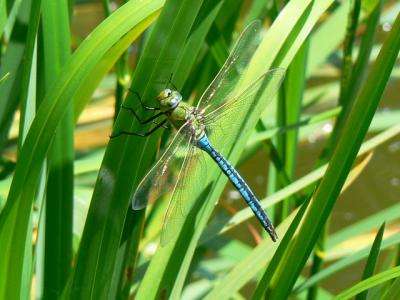Study of dragonfly prey detection wins PNAS Cozzarelli Prize

Paloma T. Gonzalez-Bellido, a postdoctoral scientist at the Marine Biological Laboratory (MBL) and her colleagues have been awarded a 2012 Cozzarelli Prize by the editorial board of the Proceedings of the National Academy of Sciences (PNAS).
Gonzalez-Bellido and colleagues were honored for the "scientific excellence and originality" of their study of prey detection and interception in dragonflies, which won in the category of "Biological Sciences." Out of more than 3,700 papers published in the journal last year, the editors selected Gonzalez-Bellido's paper and five others for the Cozzarelli Prize.
The Gonzalez-Bellido paper provides insight into basic visual-motor neural processing, and has implications for the development of "bioinspired" prosthetics for humans.
"I am honored to receive recognition for this work, for which we bridged the clinical and neuroethological fields, and developed new techniques," says Gonzalez-Bellido. "This award has provided me with fuel to keep up the hard work and further my research plans."
In order for a dragonfly to intercept its prey in midair (which dragonflies do with a 95% success rate), it needs to quickly track the prey and predict its future location. To understand how they undertake this complex task, Gonzalez-Bellido and her co-authors studied a small group of 16 motor neurons, called target-selective descending neurons (TSDNs), in the dragonfly Libellula luctuosa. These neurons, originally discovered by co-author Robert M. Olberg in the green darner dragonfly, originate in the brain and extend to the thoracic ganglia, where the neural signal is interpreted and translated into wing muscle movements. Surprisingly, the scientists found that this small group of neurons can detect the direction of target prey with high accuracy and reliability across 360 degrees, and that this information is relayed from the brain to the wing motor centers in population vector form.
In 1988, co-author Apostolos Georgopoulos and his colleagues showed in monkeys that from the activity of neurons in the motor cortex, the population vector algorithm can predict the monkey's upcoming arm movement. However, to achieve a more accurate prediction with this algorithm, upwards of 200 neurons were needed. Thus, the present discovery that a highly accurate neural code carrying information about target direction can be achieved with just 16 neurons is enlightening, and could have applications in the development of bioinspired robots. (Georgopolos is an MD-PhD at the University of Minnesota/Veterans Administration Medical Center who is interested in the development of prosthetics.)
Randy Schekman, PhD, editor-in-chief of PNAS, describes the papers chosen for the Cozzarelli Prize as being "of exceptional interest… These papers are not merely technically superior but have had special impact and maybe novel techniques or novel applications of techniques, or very important discoveries."
To measure the voltage change in the dragonfly neurons, Gonzalez-Bellido used a classical technique called intracellular recording, which was originally developed by Kenneth S. (Kacy) Cole at the MBL and others. This technique, she says, provided very clear, high-quality data in the dragonfly, which she sees as a promising model for understanding the evolution of neural systems. "It's exciting that the same computation [the population vector algorithm] is used by monkeys and dragonflies for this task. Dragonflies belong to the most ancient groups of flying insects on earth, and they have changed little in 250 million years" she says.
More information: Gonzalez-Bellido PT, Peng H, Yang J, Georgopoulos AP and Olberg RM (2012) Eight pairs of descending visual neurons in the dragonfly give wing motor centers accurate population vector of prey direction. PNAS 110: 696-701 /doi/10.1073/pnas.1210489109
Journal information: Proceedings of the National Academy of Sciences
Provided by Marine Biological Laboratory



















